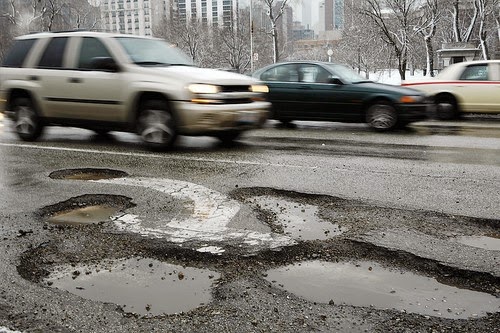Contrary to conventional wisdom in the state Capitol, a new report shows that many Michigan rural counties are plagued by roads in worse shape than those in the cities and suburbs
Gov. Gretchen Whitmer has vowed to overhaul the state’s distribution of road taxes so that more money flows to urban areas, at the expense of rural counties. But an analysis of road conditions across Michigan by the MLive news network finds that most of the counties with the worst major roads and highways are in rural areas, including Up North, not in heavily populated southeast Michigan or west Michigan.
Relying on data compiled by the Michigan Transportation Asset Management Council, the report looked at what roads are in good, fair or poor condition in each of the 83 counties. MLive found that Manistee County in northern Michigan has the worst roads, with 67 percent in poor shape.
Other counties with a large percentage of roads that are ranked poorly include Cheboygan, Newaygo and Crawford counties, each with a population of less than 50,000 and well over half of their roads rated in poor condition. In fact, on the list of the 20 counties with the worst roadways, only Saginaw County doesn’t fit the definition of a sparsely populated area.
In contrast, the Detroit area — Wayne, Oakland and Macomb counties – has poor roads that amount to between 41 and 47 percent of the total. Kent County (Grand Rapids) and Genesee County (Flint) also have relatively good roads compared to many other counties. Kalamazoo County, Washtenaw County and Ingham County each have less than 40 percent of their roads rated as poor.
Because Michigan has essentially relied on the same road funding formula for 68 years, disbursement of money means that a two-lane highway in the Upper Peninsula is treated the same as a six-lane interstate freeway in Wayne County. For decades, Detroit area lawmakers have argued that their heavily trafficked roadways deserve a much bigger share of the pie.
Clearly, the state’s urban areas have much larger traffic volumes and far more five- and six-lane roads than the counties Up North. Those are key factors, along with heavy truck traffic, that make road repairs and reconstruction more expensive and more frequent in the state’s large cities and suburbs.
But the longtime assumption that the worst roads are in cities and suburbs is true only in terms of volume, not percentage. For example, Cheboygan County, located at the northern tip of the Lower Peninsula, has 800 miles of major roads, 64 percent of which are rated poor. Macomb County in suburban Detroit has 2,841 miles of major roads, with 41 percent labeled poor.
These road surface ratings do not refer to neighborhood streets or lightly traveled local roads. The reference is to freeways, highways and other major thoroughfares that are eligible for federal funding assistance.
It should be pointed out that all of the counties with the best roads only have about one-third that are rated good. All of the top 20 are in the 30 to 39 percent range. In other words, listing the counties with the “best” roads holds a special connotation in Michigan, where overall conditions have been ranked the worst among the 50 states.
A February report produced by the nonpartisan Citizens Research Council of Michigan noted 69 percent of state road-miles are in rural areas, yet rural areas account for just 30 percent of traffic.
Whitmer has proposed that new road funding generated by her proposed 45-cents-per-gallon gas tax hike should be distributed in a different manner than what has been the norm since 1951. She wants nearly half of the money to go to the interstates and freeways that are maintained by the Michigan Department of Transportation. Another 30 percent would be awarded to heavily trafficked roads and highways that are under the jurisdiction of MDOT, large counties or big cities.
“Outstate drivers would clearly be losers, and the urban drivers would be the winners under this proposal,” Ken Boyer, an economics professor at Michigan State University who studies transportation funding, told Bridge Magazine.











